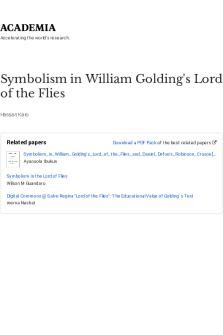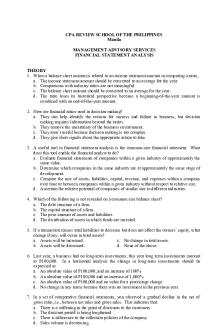In memoriam, by Alfred Lord Tennyson - In Memoriam PDF

| Title | In memoriam, by Alfred Lord Tennyson - In Memoriam |
|---|---|
| Course | StuDocu Summary Library EN |
| Institution | StuDocu University |
| Pages | 2 |
| File Size | 73.6 KB |
| File Type | |
| Total Downloads | 114 |
| Total Views | 139 |
Summary
Download In memoriam, by Alfred Lord Tennyson - In Memoriam PDF
Description
In memoriam, by Alfred Lord Tennyson. Introduction One of the most influential Victorian poems, Alfred Lord Tennyson's In Memoriam (1850) is actually 133 poetic fragments or sections that differ in theme, tone, and presentation, but are all unified by the poetic persona's grief, doubt, and search for faith. The composition of In Memoriam was initiated by Tennyson's deep suffering at the loss of his brilliant young friend, the promising poet and scholar Arthur Henry Hallam, who died suddenly in 1833 at the age of twenty-two. Although many of the sections were written in the three years following Hallam's death, when Tennyson's grief was most acute, he continued adding to and rearranging his long poem as science and religion shook traditional beliefs in God and Christianity. Finally, in 1850, Tennyson published his lyrical elegy. Immediately well-received, it brought Tennyson considerable fame and was undoubtedly influential in the decision to appoint Tennyson as William Wordsworth's successor as British poet laureate. Plot and Major Characters Although the 133 individual sections of In Memoriam present varying stages of doubt, faith, and consolation, they are all unified by the abba stanza form. Originally, Tennyson intended to call the poem “Fragments of an Elegy,” and later often referred to his work as “The Way of the Soul.” The actual title, however, was suggested by Emily Sellwood, Tennyson's future wife. In Memoriam has been argued by some critics to be deeply autobiographical, while others contend that it is foremost artistic and fictional; Tennyson himself claimed that the poem is actually the voice of all humanity, and not his own. The style and form of the emotional verse preclude conclusive identification of more than a few characters. There may also be no definitive answer to the question of genre, as its interior struggle is both highly personal and universal. The poem expresses deeply personal emotions and questions of faith, often directly resulting from the loss of Hallam. Contradictions abound, however, and with each assertion of doubt in God, Tennyson complicates the emotion by offering verses, or even single images or words, of hope and renewal. This culminates in section 95 when the poetic voice is reunited with the spirit of Hallam through a mystical experience. Finally, while closure is never truly found, the poem ends with a sense of consolation. Loss is accepted, faith is affirmed, and the presentation of a marriage leaves the reader with a measure of hope. Major Themes Most critics agree that In Memoriam can readily be divided into four sections marked by the three Christmas celebrations following Hallam's death. The mood progresses from despair, longing, doubt, and sorrow to hope, inner-peace, and faith. The poem considers death and the stages of bereavement as the narrator experiences intense grief, nostalgia, and disconsolation, as well as the contemplation of immortality with the desire for a future reunion with the dead. The eventual outcome of this renewed faith is tempered with knowledge of scientific advancement and is necessarily compatible with it. In Memoriam seeks to represent man's journey to understand suffering, love, and his own purpose. Critical Reception Criticism of In Memoriam has been rich and varied. During Tennyson's lifetime, his poem enjoyed universal acclaim. The Victorian reader shared his own spiritual doubt with the narrative voice of the poem and found solace. After Tennyson's death, his poem and his reputation alike
suffered critical backlash. Many twentieth-century readers found the dramatic melancholy and the questioning of faith to be dated and naïve. The early twentieth-century vogue for dismissing Tennyson, and likewise In Memoriam, has largely passed, and critics since the 1960s have been greatly interested in the poem. Many scholars, including K.W. Gransden, consider In Memoriam to be an elegy. Gransden finds Tennyson's approach too tentative and exploratory as it seeks to adequately convey the poetic vision. Other critics have explored the influence of nineteenth-century scientific discovery on both Tennyson as a thinker and writer and on Victorian religious beliefs. One critic, Robert Dilligan, turned to computer analysis to help unravel the syntax and prosody of In Memoriam. The vehemence with which Tennyson's poem longs for the lost Hallam has led some critics, including Christopher Craft, to examine the homoerotic underpinnings of the poem and to question whether the obvious passages of male love are simply written with a sensibility unique to its time or are indicative of a different level of comfort with homosexuality. Likewise, analyses of the poem's linguistic structure, poetics, language, symbolism, and structure abound. In Memoriam remains an important work for critical examination as its themes of grief, doubt, loss, and longing are universal to humankind....
Similar Free PDFs

In memoriam
- 24 Pages

Lord-Durham’s - lord
- 23 Pages

Symbolism In Anthem by Ayn Rand
- 2 Pages

A course in modren linguistics by Hocett
- 636 Pages
Popular Institutions
- Tinajero National High School - Annex
- Politeknik Caltex Riau
- Yokohama City University
- SGT University
- University of Al-Qadisiyah
- Divine Word College of Vigan
- Techniek College Rotterdam
- Universidade de Santiago
- Universiti Teknologi MARA Cawangan Johor Kampus Pasir Gudang
- Poltekkes Kemenkes Yogyakarta
- Baguio City National High School
- Colegio san marcos
- preparatoria uno
- Centro de Bachillerato Tecnológico Industrial y de Servicios No. 107
- Dalian Maritime University
- Quang Trung Secondary School
- Colegio Tecnológico en Informática
- Corporación Regional de Educación Superior
- Grupo CEDVA
- Dar Al Uloom University
- Centro de Estudios Preuniversitarios de la Universidad Nacional de Ingeniería
- 上智大学
- Aakash International School, Nuna Majara
- San Felipe Neri Catholic School
- Kang Chiao International School - New Taipei City
- Misamis Occidental National High School
- Institución Educativa Escuela Normal Juan Ladrilleros
- Kolehiyo ng Pantukan
- Batanes State College
- Instituto Continental
- Sekolah Menengah Kejuruan Kesehatan Kaltara (Tarakan)
- Colegio de La Inmaculada Concepcion - Cebu











